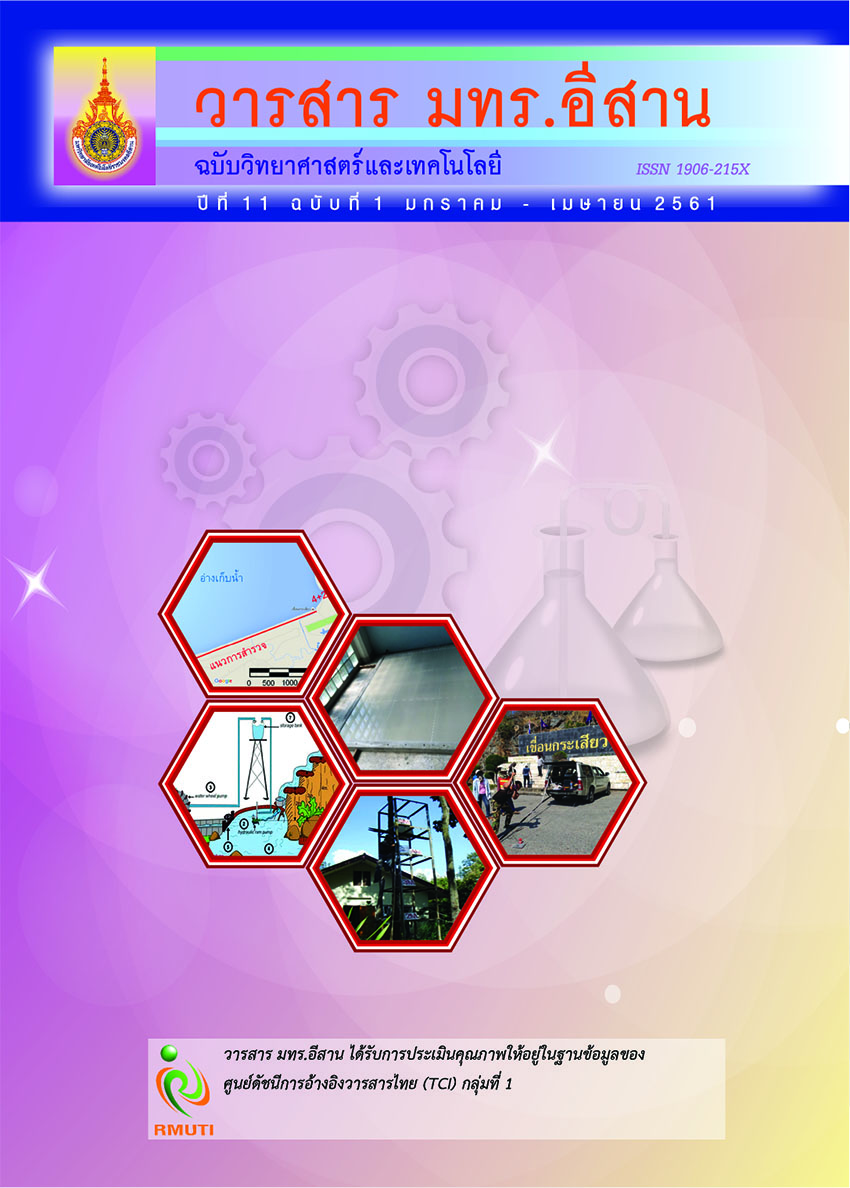Eff ect of Frying Temperature and Time on the Quality of Paprika Flavored Cassava Chips
Main Article Content
Abstract
This research was to develop cassava chips fl avored with paprika. The objective was to study
the eff ect of frying temperature and frying time on the qualities of cassava chips. Cassava
slices (0.5 mm thick) were soaked in 1 % sodium bicarbonate solution for 5 min. Then, the
cassava slices were fried at 3 levels of temperature (140, 160 and 180 oC) with frying time
of 2, 4 and 6 min respectively. Finally, cassava chips were seasoned with paprika powder,
followed by baking at 180 oC for 10 min. The chemical, physical and sensory qualities were
investigated. The result revealed that increasing the frying temperature and time caused a
decreased in moisture content, water activity (aw), breaking force and lightness (L*), but an
increased in fat content of the product. In addition, the increase of frying temperature and
time resulted in decreasing liking score of cassava chips. The optimum temperature and time
for producing cassava chips was 160 oC for 2 min. The moisture content, protein, fat, fi ber,
ash and carbohydrate of paprika fl avored cassava chips were 1.45, 1.44, 30.60, 2.04, 2.12
and 62.35 %, respectively.
Article Details
References
2017). Available (https://fi c.nfi .or.th/MarketOverviewDomesticDetail.php?id=138) (in Thai)
[2] Marketeer. (2015). Snack Market. Access (2 May 2016). Available (https://www.marketeer.
co.th) (in Thai)
[3] Srikanlayanukul, M., Cheunbarn, T., Cheunbarn, S., and Wongputtisin, P. (2012). Production
of Mold Culture Medium from Potato Chip Effl uent. Report. Maejo University. (in Thai)
[4] Offi ce of Agricultural Economics. (2016). Cassava. Access (2 May 2016). Available (https://
www.oae.go.th/ ewt_news.php?nid=21291&fi lename=news) (in Thai)
[5] Kasikorn Research Center. (2010). ‘Tiger Year’ Snacks: Intense Competition with World Cup,
9% Growth. Business Brief. K-Econ Analysis. Vol. 16, No. 2757, pp. 1-7 (in Thai)
[6] National Science and Technology Development Agency. (2011). Ministry of Science and
Technology. Strategic Planning Alliance II: SPA II. Pathumthani (in Thai)
[7] Ahza, A. B., Fidiena, T. I., and Suryatman, S. (2015). Physical, Sensorial and Chemical
Characteristics of Simulated Chips of Cassava (Manihot esculenta Crantz): Rice (Oryza sativa L.)
mix. Procedia Food Science. Vol. 3, pp. 82-95
[8] Garcia-Segovia, P., Urbano-Ramos, A. M., Fiszman, S., and Martinez-Monzo, J. (2016). Eff ect
of Processing Conditions on the Quality of Vacuum Fried Cassava Chips (Manihot esculenta
Crantz). LWT-Food Science and Technology. Vol. 69, pp. 515-521
[9] Su, Y., Zhang, W., Adhikari, B., and Yang, Z. (2016). Application of Novel Microwave-Assisted
Vacuum Frying to Reduce the Oil Iptake and Improve the Quality of Potato Chips. LWT-Food
Science and Technology. Vol. 73, pp. 490-497
[10] Yu, L., Li, J., Ding, S., Hang, F., and Fan, L. (2016). Eff ect of Guar Gum with Glycerol Coating
on the Properties and Oil Absorption of Fried Potato Chips. Food Hydrocolloids. Vol. 54,
pp. 211-219
[11] Hua, X., Wang, K., Yang, R., Kang, J., and Yang, H. (2016). Edible Coatings from Sunfl ower
Head Pectin to Reduce Lipid Uptake in Fried Potato Chips. LWT-Food Science and Technology.
Vol. 62, pp. 1220-1225
[12] Bouaziz, F., Koubaa, M., Neifar, M., Zouari-Ellouzi, S., Besbes, S., Chaari, F., Kamoun, A.,
Chaabouni, M., Chaabouni, S. E., and Ghorbel, R. E. (2016). Feasibility of Using Almond
Gum as Coating Agent to Improve the Quality of Fried Potato Chips: Evaluation of Sensorial
Properties. LWT-Food Science and Technology. Vol. 65, pp. 800-807
[13] Pedreschi, F., Mariotti, S., Granby, K., and Risum, J. (2011). Acrylamide Reduction in Potato
Chips by Using Commercial Asparaginase in Combination with Conventional Blanching.
LWT-Food Science and Technology. Vol. 44, pp. 1473-1476
[14] Akdeniz, N., Sahin, S., and Sumnu, G. (2006). Functionality of Batters Containing Diff erent
Gums for Deep-Fat Frying of Carrot Slices. Journal of Food Engineering. Vol. 75, Issue 4,
pp. 522-526. DOI: 10.1016/j.jfoodeng.2005.04.035
[15] Albert, S. and Mittal, G.S. (2002). Comparative Evaluation of Edible Coatings to Reduce Fat
Uptake in a Deep-Fried Cereal Product. Food Research International. Vol. 35, No. 5,
pp. 445-458. DOI: 10.1016/S0963-9969(01)00139-9
[16] Association of Offi cial Analytical Chemist (AOAC). (2000). Offi cial Methods of Analysis.
17th eds. Maryland : AOAC International Publishers
[17] Thai Industrial Standards Institute. (2005). Thai Community Product Standards (TCPS110/2546)
[18] Nithiya, R. (2010). Food Chemistry. Bangkok : O-dean Store (in Thai)
[19] Vilai, R. (2003). Processing Technology. 3rd eds. Bangkok: O-dean Store (in Thai)
[20] Rungnaphar, P. (2001). Analysis of Frying Process on Snack Food Products. Report.
Kasetsart University (in Thai)
[21] Kita, A., Lisinska, G., and Gołubowska, G. (2007). The Eff ects of Oils and Frying Temperatures
on the Texture and Fat Content of Potato Crisps. Food Chemistry. Vol. 102, No. 1, pp. 1-5.
DOI: 10.1016/j.foodchem.2005.08.038
[22] Mazurek, S., Szostak, R., and Kita, A. (2016). Application of Infrared Refl ection and Raman
Spectroscopy for Quantitative Determination of Fat in Potato Chips. Journal of Molecular
Structure. Vol. 1126, pp. 213-218


